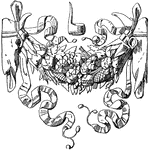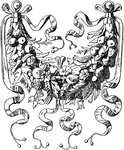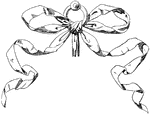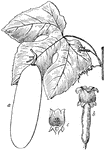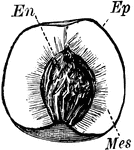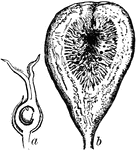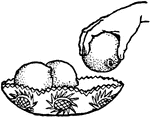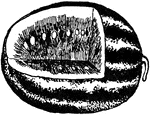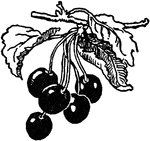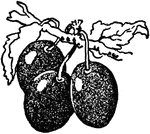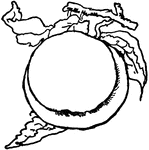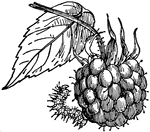
Raspberry Spanworm
The Raspberry Spanworm (Synchlora aerata) is the larva of a species of Geometer moth.

Foxglove
An illustration of: 1, Coralla cut open showing the four stamens; 2, Unripe fruit (lengthwise); 3, ripe…

False Rue Anemone
The plant and fruit of the False Rue Anemone (Isopyrum biternatum). It is a flowering plant in the Ranunculaceae…
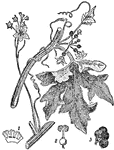
Bryony
Bryony is the common name for any of twelve species in the genus Bryonia. These are perennial, tendril-climbing,…

Laurel Ornament
The Laural is an Evergreen that blossoms a yellowish white and its fruit ball is egg shaped in a blue…

Olive Ornament
The Olive Ornament is an Evergreen that blossoms a small white oval fruit, greenish black.

Libreria Cluster
The Libreria Cluster is a fruit Festoon design found in the Cathedral of Siena, Italy during the Italian…
Tomb of Louis XVII Cluster
The Tomb of Louis XVII Cluster is a fruit Festoon design found in St. Denis, France during the French…

Tomb of Cardinal Della Rovere Festoon
The Tomb of cardinal Della Rovere Festoon is garland design found in Maria del Popolo, Rome during the…

Renaissance Strap-Work Frame
The Renaissance strap-work frame was made from bronze tablets. Foliage, palmettes, festoons and garlands…

Renaissance Strap-Work Frame
The Renaissance strap-work frame was made from bronze tablets. Foliage, palmettes, festoons and garlands…
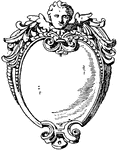
Renaissance Strap-Work Frame
The Renaissance strap-work frame was made from bronze tablets. Foliage, palmettes, festoons and garlands…

Renaissance Strap-Work Frame
The Renaissance strap-work frame was made from bronze tablets. Foliage, palmettes, festoons and garlands…

Renaissance Strap-Work Frame
This Renaissance strap-work frame was made between 1576-1577 in Germany. Made out of bronze tablets,…

Renaissance Strap-Work Frame
This Renaissance strap-work frame was made between 1576-1577 in Germany. Made out of bronze tablets,…

Dorian
The dorian (Durio zibethinus) is the fruit of the dorian tree in the Bombacaceae family. The fruit is…

Cashew Tree
An illustration of various parts of the cashew tree. "1, Branch, bearing flowers and fruit. The fruit…
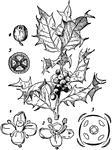
Holly
Ilex aquifolium (Holly, or European Holly to distinguish it from related species) is a species of holly…
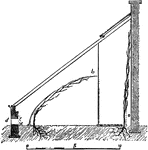
Peach House
The peach house is a structure in which the ripening of the fruit is accelerated by the judicious employment…

Eggplant
The Eggplant (Solanum melongena) is a flowering plant in the Solanaceae family of nightshades. Its fruit…

Fruit of Berberis
An illustration of the berberis fruit. Berberis (Bér-be-ris, barberry, pepperidge bush) a genus…
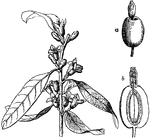
Oleaster
"Flowering Branch of Oleaster (Elaeagnus angustifolia). a, fruit; b, section of same." -Whitney, 1911
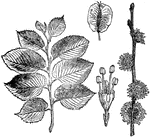
English Elm
Now known as Ulmus procera, the image shows a "Flowering Branch and Foliage of English Elm (Ulmus campestris),…

Fructification of Carrot Flower
An illustration of fructification of the carrot flower. Fructification is a term used in the plant morphology…
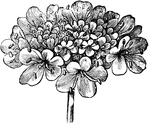
Inflorescence of Field Scabious
An illustration of the inflorescence of the field scabious. Knautia arvensis, commonly known as Field…
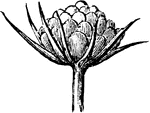
Young Inflorescence of Field Scabious
An illustration of the young inflorescence of the field scabious. Knautia arvensis, commonly known as…

Ray-floret of Field Scabious
An illustration of a ray-floret of the field scabious. Knautia arvensis, commonly known as Field Scabious,…

Ray-floret of Field Scabious
An illustration of a ray-floret of the field scabious. Knautia arvensis, commonly known as Field Scabious,…

Seed of Field Scabious
An illustration of the seed of the field scabious. Knautia arvensis, commonly known as Field Scabious,…

Sepal and Fruit of Comfrey
Comfrey (also comphrey) is an important herb in organic gardening, having many medicinal and fertilizer…

Encarpus
"In architecture, a sculptured ornament in imitation of a garland or festoon of fruits, leaves, or flowers,…

Epiphyllospermous Frond
"Part of Epiphyllospermous Frond. In botany, bearing the fruit or spores on the back of the leaves or…

Esparto Grass
"Esparto-Grasses. 1, 4, stalk and fruit of Macrochloa tenacissima. 2, 3, 5, stalk, flowering stem, and…
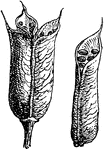
Larkspur Follicle
"Follicle. Fruit of Larkspur. A dry one-celled seed-vessel consisting of a single carpel, and dehiscent…
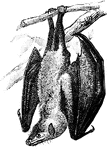
Fruit Bat Hanging from Tree
The image shows a fruit bat, a bat from the Pteropodidae family of megabats.
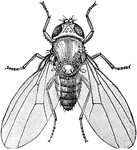
Common Fruit Fly
The Common Fruit Fly (Drosophila melanogaster) is an insect in the Drosophilidae family. The species…
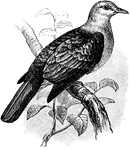
Bronze Fruit Pigeon
The Bronze Fruit Pigeon (Carpophaga aenea) is a bird in the Columbidae family of pigeons and doves.
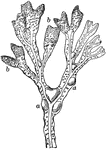
Fructifying Tip of a Frond of Rockweed
Known as rockweed or bladder wrack, this species of seaweed is in the Fucaceae family of brown algae.…

Scab Fungus
"The Scab-fungus (Venturia inaequalis). a, an infested apple, showing scabs caused by the fungus; b,…
